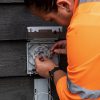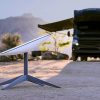Ofcom Will Tomorrow Kick Off the UK 5G Mobile Auction for 26GHz and 40GHz

The telecoms regulator, Ofcom, has today confirmed that the first bidding on their auction of the 26GHz and 40GHz millimetre wave (mmW) spectrum bands for use by 5G mobile (mobile broadband) operators will get underway tomorrow, with BT (EE), O2 (Telefonica UK / Virgin Media) and Vodafone (VodafoneThree) all taking part.
The major mobile network providers already have access to several 5G capable bands between 700MHz and 3.8GHz. Such frequencies reflect the same sort of low and mid-band radio spectrum that mobile network operators have been using since the advent of the first 3G and 4G data networks.
The move to auction off 26GHz (25.1-27.5GHz) and 40GHz (40.5-43.5GHz) will complement the existing bands by providing lots of additional spectrum frequency, which means more data capacity for extremely fast speeds (e.g. multi-Gigabit). But such signals tend to be very weak and can’t cover a wider area without a much denser / more expensive network, which in practice means they’ll primarily be used for serving busy urban areas (shopping malls, airports etc. – “High Density Areas“) and fixed wireless broadband (FWA) links.
Advertisement
The plan is to make this spectrum available in a clock auction (200MHz lots) with 15-year licences across 68 “high-density” areas (i.e. cities and select transport hubs). Bidding for this will take place in two separate stages, which we’ve summarised below. Ofcom’s reserve prices for this spectrum appears to be modest when compared with other European auctions (£2m per 26GHz lot and £1m per 40GHz lot).
The 5G mmW Auction Stages
Principal stage
Companies first bid for airwaves in ‘lots’ to determine how much spectrum each company wins in each band, but not the specific frequencies within each band. Bidding will continue for as long as there is excess demand for the spectrum available. We will announce the results of the principal stage shortly after it has concluded. Once the principal stage is underway, we will publish daily updates on our website.
Assignment stage
There is then a stage of bidding to determine the specific frequencies that winning bidders will be allocated. We will publish the final results of the auction once all stages are complete.
The 26GHz band is already used elsewhere for mmW services and so will be easier for networks operators to adopt and support, although the story is a bit different for the 40GHz band because the UK will be one of the first countries in Europe to award it. The latter may thus take a bit longer to find its feet through deployment and adoption.
Mark is a professional technology writer, IT consultant and computer engineer from Dorset (England), he also founded ISPreview in 1999 and enjoys analysing the latest telecoms and broadband developments. Find me on X (Twitter), Mastodon, Facebook, BlueSky, Threads.net and Linkedin.
« Lit Fibre Introduce New UK Broadband Pricing on National and Local Networks
Advertisement
Leave a Reply Cancel reply
Privacy Notice: Please note that news comments are anonymous, which means that we do NOT require you to enter any real personal details to post a message and display names can be almost anything you like (provided they do not contain offensive language or impersonate a real person�s legal name). By clicking to submit a post you agree to storing your entries for comment content, display name, IP and email in our database, for as long as the post remains live.
Only the submitted name and comment will be displayed in public, while the rest will be kept private (we will never share this outside of ISPreview, regardless of whether the data is real or fake). This comment system uses submitted IP, email and website address data to spot abuse and spammers. All data is transferred via an encrypted (https secure) session.






















































and all of this will be on shared existing infra, below the tree line, advertised as super hyper ultra fast technology… delivering up to 100Mbps at night for 90% cases.
Oh yay, now the new (2026) iPhones will be the same as the US models. That makes it easier for them
Why oh why doesn’t the regulator offer up for free, with a previso that there will be very stringent SLA, When all the infrastructure installed and those SLA have been met then they get the licence to operate.
Because no rational business will spent vast sums buying and installing equipment when their use of it is still conditional. Who on earth would lend them the money to do it? How the heck do you meet an SLA when you don’t have a licence to operate the kit?
Fortunately Joseph Heller doesn’t run Ofcom.
I achieve < 0.24 Mbps UL Uplink on my 5G gNodeB. The coverage is poor, the effectiveness lousy, the contract price great. I will be cancelling my Contract when it comes up for renewal in November this year.
Is anyone sure that any of the Operators can make any money out of 5G. Surely the best thing for 5G would have been if we didn't have 3 (/4 with VodafoneThree) networks but one, but that would have been sensible. At least then the SINGLE Operator could afford to Invest in Capital at the necessary levels to operate effectively.
They would no incentive for them to do so and there would be a severe lack of consumer choice in the market. Contract prices would soar as they would likely not be sufficiently regulated in this regard and would hold the country to ransom for connectivity.
At least in the current state of affairs, there is an incentive to invest in the networks to give a USP over another.
Customers mostly have no interest in 5G, have to admit it – would be a huge waste of money. How do the bids compare to 5years ago?
You are correct, for most people it will not make any difference, even if they can get the full speed. Maybe those that uses the mobile network for their laptop, may notice it and certainly those that uses 5G at home instead of fixed line broadband. I watched a video on YouTube from explaining computers dot com a couple of days ago or so, he has just changed from FTTC to 5G mobile broadband and I was surprised how much difference it made to where the router was in the house, even on the window sill and just turned in different positions, it made a fair bit of difference. I realised that the signal would be affected in different parts of the house, and it would also affect the speed. But I did not think that just turning the router around, so the cellular antennas were towards the window, would make such a difference.
On phones, for the most part, people would not even notice as long as their video or music plays, and they can play their games, use their communication app and do other things.
I know of some people who have turned off 5G on their phones as it keeps cutting out, I know one person who is not happy, because their i presume provider, keeps turning it back on, that is what you get when you give up control of your phone to your provider.
I still have a 4G phone, it works, I can do what ever I need on it, well apart from use the front camera now 🙂 and also it slows down a bit, but it is over 4 years old. I am going to renew it soon, just not sure what to.
But even if the new phone have 5G,m it will make no difference to me.
5G is sold on speed but is vastly more robust and spectrally efficient than 4G.
It performs far better with the same spectrum in busy areas. Connections are faster and more stable.
Beamforming and increased MIMO capabilities can improve coverage.
Latency is lower and more stable.
5G is why more people are able to ditch their fixed line.
Yours, someone that switches 5G off on their own phone to conserve battery, the mobile company don’t switch it back on as that’s not a thing as far as I know, but who switches it back on when necessary as they appreciate the utility of it.
@Polish Poler, talking to different people 5G don’t seem to be more robust, certainly i larger cities with high rise buildings. That is why some people turn it off. It seems if you have a phone from a large provider on a contract, like Vodafone and you turn 5G off, they can turn it back on. I have a sim only contract and only 4G, the chance of me changing from a sim only contract is pretty slim, but my next phone, as I said above, may have 5G.
To the best of my knowledge, there aren’t any phones sold in the UK capable of mmWave (Iphone 17 and Samsung S25 only available on North American models).
If these devices enter the market now, it will be 5+ years before the market saturation is enough to justify deployment.
I suspect this spectrum will be pocketed and used as links for remote sites and maybe broadand.
6G development is well underway in China to roll out by 2030. This madness just takes R&D money that should be invested in the next generation of Mobile Network. Telephony is one of the only things that have reduced in price over the last 40-50 years.
I don’t see the point of it still. I’m in an area that will be under the mmWave proposals and I think it’s a waste of time when operators can’t deploy spectrum.
No O2 B38 in my area, Vodafone B38 was introduced in August alongside O2 n78 80MHz and O2 B3. No B32 from Vodafone, EE is only deploying SA at the end of the year. B8 is still half deployed on both networks, no Vodafone B3 here yet to my knowledge (O2 has it on two sites). I’d rather operators would be made to deploy spectrum here first, to even deploy micros would be a good start (EE has 6, rest has none) than waste time on something that will likely end up as a gimmick.
So all the selling of phones from
The last few years were never on
A 5g network yet provers mistress sold
As 5g is re with generation.
Sounds like a case of fraud.